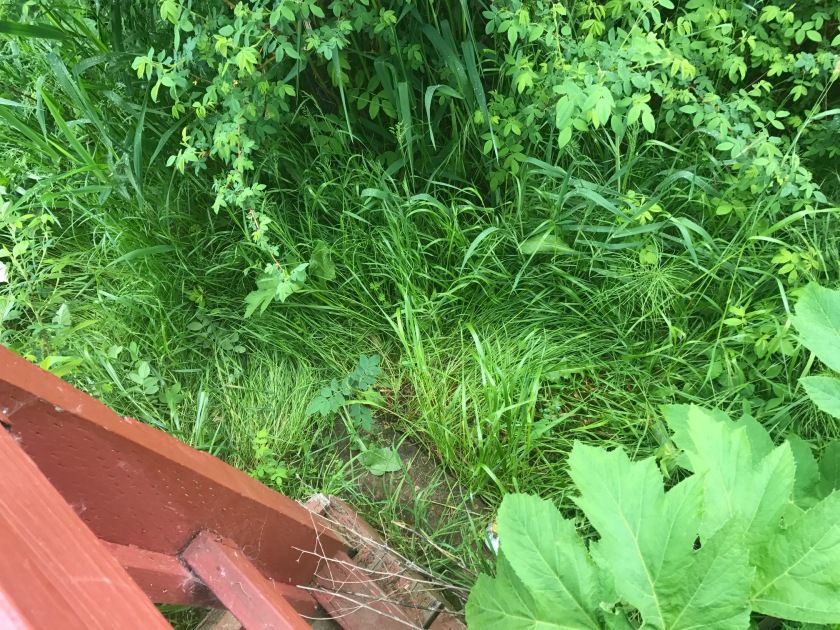Geocaching is an activity that anyone with an internet connection and a handheld GPS can do. If you don’t have a hand held GPS most modern smart phones can also be used. The first thing you’ll want to do is to sign up for an account on Geocaching.com. Then find a nearby geocache. With a free account you’ll be a little limited on the size of the caches you will be allowed to find, but that doesn’t matter too much. The best thing about geocaching is that you get to see places other people have found that you’d never expect to find. If exploring is something you enjoy doing you’ll definitely enjoy geocaching. I first got into it around 2003 or 2004. I got got into the Bronco, which happened to be working today and went to a local spot that I knew had a geocache. This Geocache is located about a mile and a half south of downtown Hillsboro along Highway 219.
The day was a bit rainy but it was a chance to enjoy a bit of outdoors again so I didn’t mind too much. The first thing to do when looking for a geocache is to get within a respectable distance of the geocache – or at least within walking distance. For this one I chose a geocache called “For the Birds”. I captured screen shots from my iPhone to show the details of this geocache. There are several screens that show detailed information about the cache but the most important parts are the details, description, the map once you get started, and if needed any hints the cache might require. The object is to “log” the cache and once found most people will write “TFTH” which means “Thanks for the Hunt” or other kinds of short hand.



Keep in mind the best thing about geocaching is to see new and experience new places. For this cache I won’t ruin the surprise and show where the cache is exactly, but I’ll give a few hints. While I walked along the trails in Jackson Bottom wetlands this rather rainy spring day I could hear all of the birds singing and the plants were all blooming. It really makes one appreciate living in the Willamette Valley. The folks at Jackson Bottom Wetlands do a fantastic job of maintaining the wetlands and it’s a wonderful way to spend a few hours.

All too soon I found myself at the geocache location, it’s a small observation spot that has a roof and some small places to sit. The geocache is cleverly hidden. If you have some struggles you might read the hint. Additionally, if you look around the area – for this geocache you might look for some knocked over foliage – those might indicate where other geocachers looked for the cache.



Be careful though, as most of the descriptions of the caches warn against “muggles” – those who are familiar with Harry Potter will recognize the word, in this instance it’s people who don’t geocache. So remember to be careful and do your removal and replacement of the geocache itself while out of the view of non-geocachers.

My first GPS was a Magellan Meridian, I still have a version of it (the original took a leap off the roof of my truck one day about eight or nine years ago). Nowadays the best thing (in my opinion) to use for geocaching is a smart phone as it can be used to log into the geocaching website to get the cache information, log the cache when it’s found, get hints if needed, and add pictures. The Magellan Meridian I started with was fantastic but only used the GPS coordinates to find the location and even then could only get to within a limited area of the geocache – as the technology wasn’t as good as it is today. Nowadays caches can be found easier because modern GPS devices are much more accurate.
One of the best things about geocaching is that you’re allowed to create your own geocaches. Once you’ve found a few and know a good location that you’d like other people to see you’ll be able to download a log sheet and hide a container and post the location. The first geocaches I hid were in 2005 and I still have the log sheets from them. They remained up for a few years and I eventually took them down as the place where I hid the geocaches got a little run down and one in particular flooded a few times. The front page should always be instructions for folks who accidentally discover the cache explaining what geocaching is and what to do if they accidentally find the container. The other side should be a log where geocachers can log their finds of the cache.



At this time there are over two million geocaches all around the world on every continent – I’ve even found geocaches in Iceland!! Although I haven’t found as many geocodes as some folks have, I can say it’s a very worthwhile activity and one that the whole family can and will enjoy.

